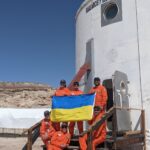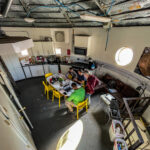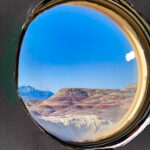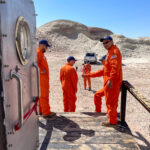Crew 265 – Mars Society
Crew Commander/Cartographer: Marc Levesque (United States)
Executive Officer/Crew Engineer: David Laude (United States)
Crew Engineer/Health and Safety Officer: Sergii Iakymov (Ukraine)
Crew Journalist: Sarah Treadwell (United States)
Mapping Technician: Benino Blanco (Mexico)
Mapping Technician: Isai Licea (United States)
MDRS Crew 265 is a diverse group of individuals selected from individual applications. Two members (Levesque and Laude) have been part of previous missions at MDRS, while all others will be at MDRS for the first time. The mission’s primary objectives will be to improve operations and media awareness of MDRS. Projects will include testing a new radio communications system, updating the EVA planning map, tracking energy consumption, testing station device batteries, and increasing social media presence. The crew’s daily priority will be to maintain all MDRS facilities, vehicles, and equipment in a safe and operable condition.
Below is a detailed summary of planned projects during the mission.
Radio Communications Project
Marc Levesque
The Mars Desert Research Station is situated in a secluded area surrounded by low hills. Radio communications between the Hab and EVA teams use small handheld radios on a UHF frequency of the General Mobile Radio Service (GMRS) band. These handheld radios are limited to five watts of power and rely upon line-of-sight communications. Previous MDRS crews have noted communications issues between the Hab and EVA teams, however. Of significance is the loss of communications between the Hab and EVA teams when the latter have traveled into areas beyond hills that block transmissions and reception, a common issue with UHF frequencies and line-of-sight communications in such terrain.
This problem has been noted by Station Support personnel and other crews. In 2016 Bernard Dubb offered solutions to improve communications at MDRS using a more powerful radio system retaining the handheld GRMS radios but adding a more powerful base station radio inside the Hab with an outside antenna. An alternative solution was the installation of a small repeater system away from the Hab.
During MDRS 216, the crew identified a location through geospatial analysis for the installation of a small radio repeater to potentially extend the range of communications between the Hab and EVA teams. This location on North Ridge was reached on foot during an EVA to determine the feasibility for the installation of a temporary repeater at that site, as well as for any maintenance required during its period of operation.
During MDRS 265, a small repeater will be installed on the North Ridge. It will operate in cross-band mode that allows a UHF signal to be re-transmitted to a VHF signal and vice versa. This will permit the Hab to transmit line-of-sight to the repeater on the currently-used GMRS UHF channel. EVA teams will then use dual-band VHF/UHF handheld radios programmed to transmit to the repeater using a VHF frequency licensed to Western New Mexico University. Because these project radios will transmit on a VHF frequency to a repeater located on a high point, it is expected that EVA teams will be able to travel much farther while still remaining in radio communication with the Hab.
The project radios will include the currently-used GRMS UHF channel, providing the ability to talk directly with the Hab, rather than through the repeater if necessary. These radios will also use longer antennas than the current MDRS radios and can transmit up to five watts.
During MDRS 265, EVA teams will travel to sites normally visited by EVA teams and beyond. Teams will carry an existing MDRS radio and a project radio to test the signal strength and voice clarity of each with a Hab communications operator. These indices and location coordinates will be noted on a project map to capture the difference in communication between the two radios. The intent is to determine the value of a new communications system using a VHF frequency for enhancing crew safety during EVAs.
EVA Planning Map
Marc Levesque, Benino Blanco, and Isai Licea
Prior to entering sim, the crew cartographer and mapping technicians will meet with the Station Director to review and assess needed changes to the current EVA Planning Map. During sim, the mapping cadre and other crew members will then conduct several EVAs to collect or ground truth via GPS various features, points of interest, road conditions, and other desired changes to provide the needed edits and additions. This work will build upon the GIS files developed by Henrik Hargitai and others from 2006 to 2016 to create the current EVA map. To leverage time in the field, the mapping project EVAs will run concurrently with the radio communications EVAs that will capture radio signal strength and clarity. After a review of the collected data by the Station Director, a map will be generated post-mission and submitted for approval and final printing.
Smart Home Technologies for an Analog Mars Habitat
Sergii Iakymov
Space exploration is hard on systems, and all manned spacecraft are automated. Automated technologies do most of the routine procedures on their own and only notify crew and ground control if something is wrong. No doubt future habitats on Mars will be very smart to free up time for the crew to do research. Analog astronauts at MDRS also require extra time for research. That time can be gained by implementing Smart Home technologies that will take over some routine procedures.
The project goal is to implement Smart Home technologies during an analog simulation at MDRS. We will study how automated technologies can improve daily life at the station, how much time it will free for the crew, and how it will help ground control to collect data from the station.
For this engineering research, currently available Smart Home devices will be used. Main points of this approach include:
1) Analog simulation at MDRS is relatively short, up to two weeks. Therefore, simplified setup procedures are necessary.
2) The approach will not interfere with station construction.
3) In case of a malfunction, any device will be easily replaced from inventory.
4) There is no need to design new devices.
5) Minimizing system development time by using existing free tutorials.
6) Research will show how this system will improve analog simulation.
7) Using plug-and-play devices where possible.
8) In some cases, where plug-and-play devices cannot be used, permission to wire into the power circuit will be obtained.
The type of Smart Home devices to be used include a Raspberry Pi server, control terminal, temperature sensors, humidity sensors, air pressure sensors, door sensors, smart plugs, smart light control, and remote controls.
The proposed engineering research will have two main phases:
1) The first phase will observe daily crew routine and how different electrical equipment is being utilized. Every day meetings will be conducted to survey crew requirements for the Smart Home system. At the same time, a Smart Home server and environmental sensors will be installed and configured.
2) The second phase will install Smart Home technologies based upon crew recommendations. After installation, crew training will be conducted, and the devices turned on. During phase two, all systems will be monitored daily, and crew feedback logged.
At the end of the project, all Smart Home devices will be unplugged and collected. Later, a project report will be submitted to the Station Director.
Battery Testing
Dave Laude
The many portable devices at MDRS use batteries, all with finite life and various ages, resulting in some device failures for nearly every crew. For this project a battery analyzer will be used to test all suspected failed EVA suit and all operating radio batteries. All batteries installed in EVA suits will be tested in parallel by charging to full and then running the fans continuously, checking battery voltage at time intervals for up to four hours. Following the tests, labels will be attached to each radio battery and suspect EVA suit battery indicating a test serial number, date of test, battery capacity, and “good”, “fair” or “failed”. All results will be sent to mission support.
Social Media Presence
Sarah Treadwell
This project will document the MDRS experience in a journalistic style, conducting interviews and issuing daily reports. Of particular interest will be to look at the human condition, examining the mentalities and psyches throughout the course of the crew’s mission. The project will utilize modern social media methods to share the experience for promotional purposes and to educate the public via YouTube, Facebook, Instagram, TikTok, and others. A connection to Blue Marble Space platforms will also help promote coverage of the experience and connection between the organizations. Permission to be interviewed and filmed will be obtained from each crew member prior to project commencement.
Submitted by:
Marc Levesque
Crew 265 Commander







You must be logged in to post a comment.